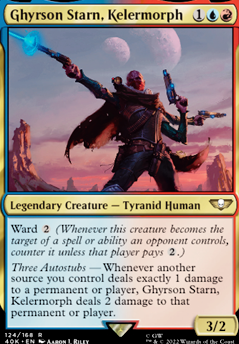| Date added | 5 months |
| Last updated | 2 months |
| Legality | This deck is Commander / EDH legal. |
| Rarity (main - side) | 10 - 0 Mythic Rares 43 - 0 Rares 16 - 0 Uncommons 20 - 0 Commons |
| Cards | 100 |
| Avg. CMC | 2.68 |
| Tokens | Copy Clone, Coruscation Mage 1/1 R, Insect 1/1 UR |
| Folders | Commander |
| Votes | |
| Ignored suggestions | |
| Shared with | |
| Views |
Creature (26)
- 1x Blisterspit Gremlin
- 1x Chandra's Incinerator
- 1x Cinder Pyromancer
- 1x Coruscation Mage
- 1x Cunning Sparkmage
- 1x Exalted Flamer of Tzeentch
- 1x Gimli, Counter of Kills
- 1x Goblin Chainwhirler
- 1x Goblin Sharpshooter
- 1x Kessig Flamebreather
- 1x Kira, Great Glass-Spinner
- 1x Niv-Mizzet, Parun
-
1x
Niv-Mizzet, the Firemind

- 1x Prodigal Pyromancer
- 1x Prodigal Sorcerer
- 1x Razorfin Hunter
- 1x Sakashima of a Thousand Faces
- 1x Spark Double
- 1x Tandem Lookout
- 1x The Locust God
- 1x Thermo-Alchemist
- 1x Toralf, God of Fury Flip
- 1x Unruly Catapult
- 1x Vulshok Sorcerer
- 1x Witty Roastmaster
- 1x Zuran Spellcaster
Enchantment (9)
Land (35)
- 1x Arcane Lighthouse
- 1x Arid Mesa
- 1x Bloodstained Mire
- 1x Cascade Bluffs
- 1x Command Tower
- 1x Desert
- 1x Exotic Orchard
- 1x Flooded Strand
- 1x Frostboil Snarl
- 5x Island
- 1x Mana Confluence
- 1x Mikokoro, Center of the Sea
- 1x Misty Rainforest
- 6x Mountain
- 1x Polluted Delta
-
1x
Reflecting Pool

- 1x Reliquary Tower
- 1x Scalding Tarn
- 1x Shivan Gorge
- 1x Shivan Reef
-
1x
Steam Vents

- 1x Sulfur Falls
- 1x Temple of Epiphany
- 1x Training Center
- 1x Witch's Clinic
- 1x Wooded Foothills
Sorcery (6)
Commander (1)
Artifact (14)
- 1x Arcane Signet
- 1x Basilisk Collar
- 1x Caltrops
- 1x Fellwar Stone
- 1x Helm of the Host
- 1x Izzet Signet
- 1x Lightning Greaves
- 1x Resurrection Orb
- 1x Ruby Medallion
- 1x Sapphire Medallion
- 1x Shadowspear
- 1x Sol Ring
- 1x Swiftfoot Boots
- 1x The Millennium Calendar
Instant (9)
Suggestions
Updates Add
Comments
Attention! Complete Comment Tutorial! This annoying message will go away once you do!
Important! Formatting tips — Comment Tutorial — markdown syntax
Please login to comment
94% Casual
Competitive
| Date added | 5 months |
| Last updated | 2 months |
| Legality | This deck is Commander / EDH legal. |
| Rarity (main - side) | 10 - 0 Mythic Rares 43 - 0 Rares 16 - 0 Uncommons 20 - 0 Commons |
| Cards | 100 |
| Avg. CMC | 2.68 |
| Tokens | Copy Clone, Coruscation Mage 1/1 R, Insect 1/1 UR |
| Folders | Commander |
| Votes | |
| Ignored suggestions | |
| Shared with | |
| Views |

